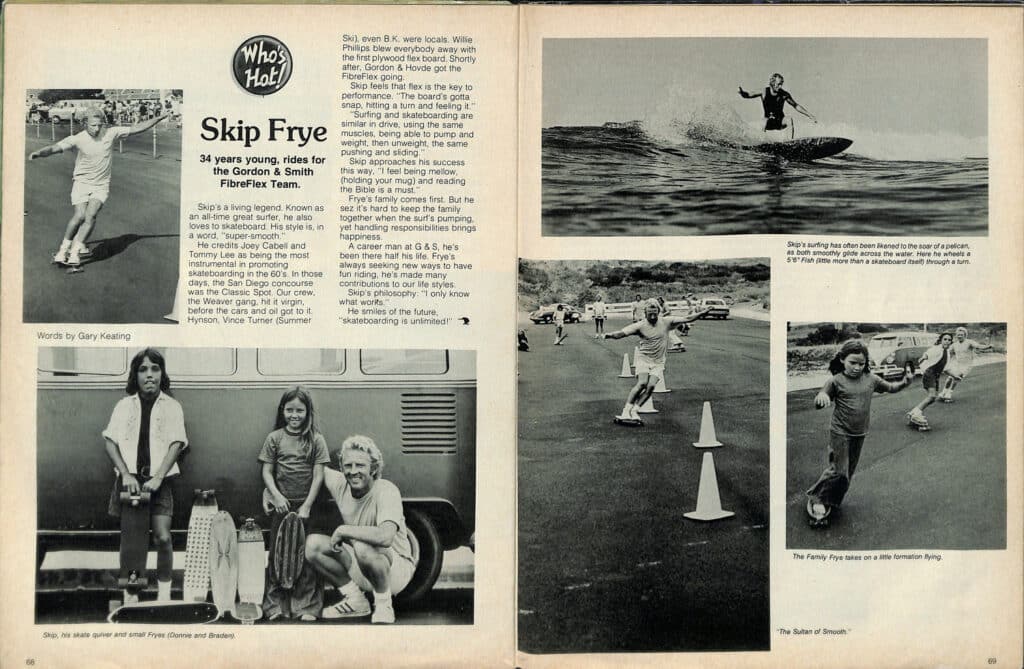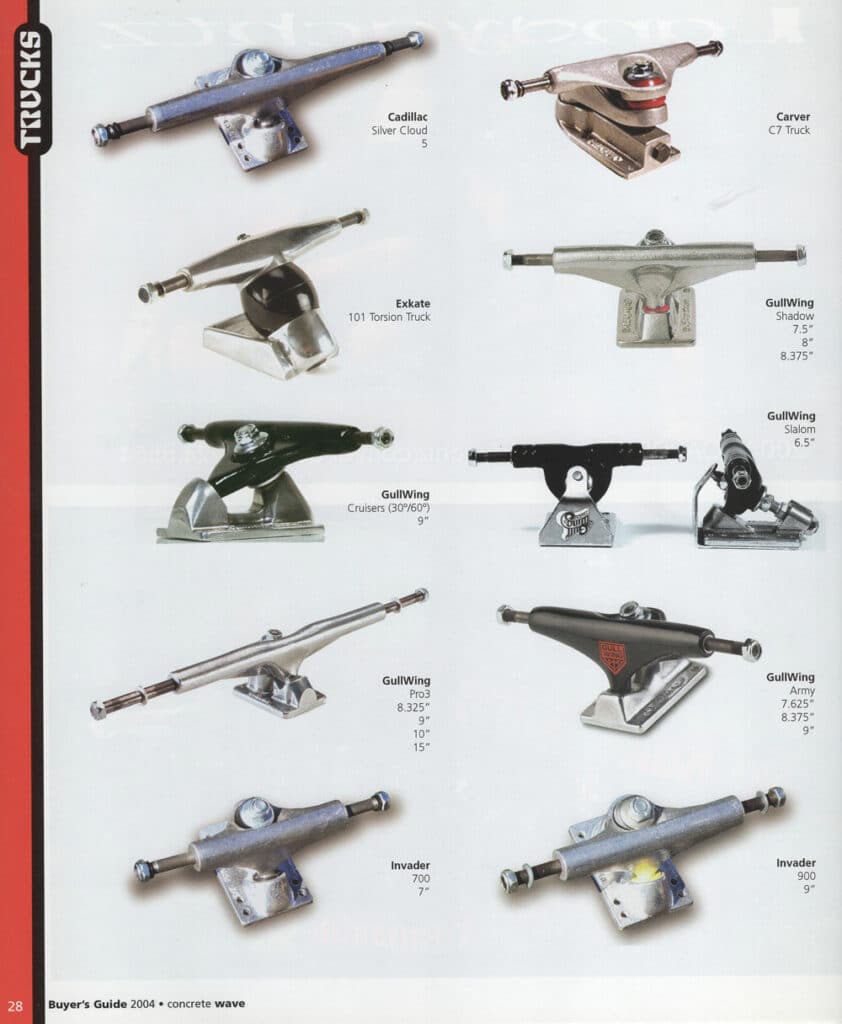The past few years, surfskates have exploded in popularity. But you might be surprised just how long it’s taken for them to get this recognition. This is a brief history of surfskates.
Believe it or not, you have to go back over a quarter century to see where the seeds of modern-day surfskating were planted.
Before this recent wave of surfskating, it’s important to acknowledge surfing’s impact on skateboarding during its formative years. When surfers dismantled their roller skates and put them on 2 x 4’s in the late 50s early, 60s.
Skateboarding’s popularity was fueled by professional surfers like Skip Frye and Mike Doyle. They gave it the credibility it needed to be pushed to new heights.

(Vol2 No3 – Winter 1975)
Brands like Makaha and Hobie appealed to millions who wanted to go “sidewalk surfing.”
So since the early days, skateboarding’s roots have been intertwined with surfing.
But for many generations, it drifted away from surfing, focusing heavily on one style – street skating.
Personally, I think street skating’s rapid progression of technical tricks made it the most appealing to the mainstream and was necessary to take skateboarding to new heights. But that’s a topic for another article.
The Skateboarding scene in the mid 90’s was a lot different than what you see today. The internet was slow, there were no smartphones, no social media and Google didn’t even enter the picture until 1998.
Skate magazines covered street almost 100%. And so if you introduced a product that didn’t fit into that style, it was extremely hard to drive any attention to it.
Throughout the years, there were many attempts to reconnect surfing and skateboarding. But none were truly significant enough to catch traction.
Like in 1996, surfers David Colley, Brad Gerlach and his father Joe came up with a skateboard that emulated surfing called the Carveboard.

While it did a good job at capturing the aggressive surf movements, it didn’t explode in popularity. I’m sure there were several factors but I think it was because the skate industry wasn’t ready for it.
Carveboard was one of the first real attempts at reconnecting surfing and skateboarding in the modern-age.
It’s also worth noting some other companies with similar visions during this time period.
- Seismic’s trucks that used a dual spring system
- Exkate torsion trucks
- Revenge Trucks which can still be found on several skateboards today.
- Original trucks which eventually made their way onto Hamboards.

2000
So you can see, there were many attempts at creating a surfy skateboard experience. But none of them were able to do it as successfully as Neil Stratton and Greg Falk of Carver Skateboards.
Carver pioneered what we now know as the surfskate. It can be argued that all those pivoting spring adapters that currently exist – wouldn’t be without them.

2004
Their story begins in 1996 when Neil and Greg decided to dedicate their life to figuring out the intersection of surfing and skateboarding.
The waves were flat, and Neil got bored of his industrial engineer job designing chairs.
Like anything new, a ton of testing and tweaking went into making their trucks.
Neil estimates he probably made 25 prototypes before they felt comfortable testing it on the steepest road in their neighborhood – Venice’s Marine Street.
Their biggest obstacle was creating a truck that didn’t feel twitchy. Anyone can create a truck, but not everyone can figure out how to make the front and back trucks work seamlessly together.
In the early days of Carver, it was extremely difficult to get traction.
The skateboard industry likes to think of it being pretty progressive, but the reality is that it hates change.
Longboard companies like Sector 9 were completely dismissed when they first started back in 1993.
One of the most challenging things for Carver in the early days was people didn’t want anything different. They just wanted the thing that they already knew.
Greg and Neil tried their hardest to get people to understand their surfskates, but shops and distributors didn’t bite.
The lack of interest was tough for them because they thought they created something that would be immediately embraced.
They tried for years to gain some acceptance, but it wasn’t until they pivoted their brand from a skate company to a surf company that was a game-changer for them.
Japan was where they initially found success because of the huge number of passionate surfers. There were no preconceptions of what skateboarding should be, like in the US.
From there, other places like Brazil and Vancouver began to use their surfskates.
As a result, surfskate parks started popping up around the world.
It should be noted that while Carver was quietly doing its thing, the biggest longboard company in the world – Sector 9, was beginning to take notice. Sector 9 wasn’t just a massive longboard company; at the time, they were one of the biggest skateboard companies.
Sector 9 decided to offer something that carved harder than the traditional trucks that came with their completes. In the mid 2000’s they introduced their Gullwing trucks. You might be surprised to learn that Neil helped tweak the design of this truck to fit Sector 9’s setups.
Having one of the largest skateboard companies promote the concept of a surfskate was extremely helpful.
Larger company, larger marketing budget = larger exposure.
As the surfskate market slowly grew, several competitors joined Carver. Including Smoothstar, Hamboards, YOW &

2004
We’ll get a chance to get into the history of some of the more recent companies in another article.
So what was it that helped surfskating become a popular and sustainable market?
While many factors over the years added up, in my opinion, it was a combination of a few things.
- One, the skateboard industry needed to become more open to other styles. This just took time for it to evolve.
- Two, there needed to be a visionary that understood the importance of connecting the technical aspects of product design and the riding experience. Before Carver, most brands failed to understand how important this was.
- Three, in recent years there were several companies offering a surfskate system that actually felt soulful to ride. It wasn’t just marketing hype – so having a handful of high quality brands pushing the industry forward was vital.
- And four, the ability to rapidly share photos and videos on social media, mixed with those searching for a new hobby due to the pandemic’s lock downs and boom – the popularity of surfskating exploded.
Time will tell what this style of skateboarding will evolve into, but one things for sure, surfskating is here to stay.



